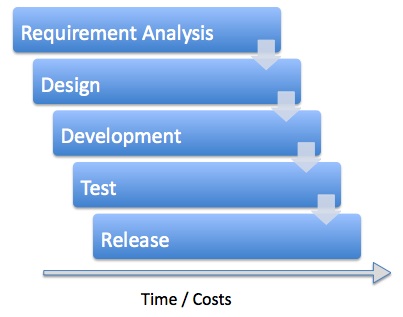Studies have shown that in over 80% of the investigated and failed software projects, the usage of the Waterfall methodology was one of the key factors of failure. But why?

Phases in the Classical Waterfall Software Development Model
As shown above, when deploying the waterfall methodology there is a strict sequential chain of the different project phases. A previous phase has to be completed before starting the next phase. Going back is in most cases difficult, costly, frustrating to the team and time consuming.
The project timeline is planned at the start. A releasable product is delivered only at the end of the project timeline. If one phase is delayed all other phases are also delayed.
To avoid this users of the waterfall methodology normally try to anticipate all possibilities beforehand. This means that in one of the earliest phases of the project they try to define all requirements as fine grained and complete as possible. However, requirement definition in such an early phase of the project is often very difficult and therefore many requirements change (or should change) throughout the project. Studies have shown that in larger and complex projects about 60% of the initial requirements are changed throughout the project. Other requirements are implemented as defined but are not really needed by the customer and consume valuable time that could have been better used to implement functionality with a higher added value for the customer.
The separation into different project phases force users to estimate each phase separately. The problem is that most of these phases are normally not separate. They are working together and in parallel.
The waterfall approach for developing software can be used for implementing small and simple projects. But for bigger and more complex projects it can be said that this approach is highly risky, often more costly and generally less efficient than Scrum Project Management Framework.
The iterative waterfall model provides feedback paths from every phase to its preceding phases, which is the main difference from the classical waterfall model. .A quick look at the various options -
Iterative Waterfall Model: The Iterative Waterfall model is probably the most used software development model. This model is simple to use and understand. But this model is suitable only for well-understood problems and is not suitable for the development of very large projects and projects that suffer from a large number of risks.
Prototyping Model: The Prototyping model is suitable for projects, which either the customer requirements or the technical solutions are not well understood. This risks must be identified before the project starts. This model is especially popular for the development of the user interface part of the project.
Evolutionary Model: The Evolutionary model is suitable for large projects which can be decomposed into a set of modules for incremental development and delivery. This model is widely used in object-oriented development projects. This model is only used if incremental delivery of the system is acceptable to the customer.
Spiral Model: The Spiral model is considered as a meta-model as it includes all other life cycle models. Flexibility and risk handling are the main characteristics of this model. The spiral model is suitable for the development of technically challenging and large software that is prone to various risks that are difficult to anticipate at the start of the project. But this model is very much complex than the other models.
Agile Model: The Agile model was designed to incorporate change requests quickly. In this model, requirements are decomposed into small parts that can be incrementally developed. But the main principle of the Agile model is to deliver an increment to the customer after each Time-box. The end date of an iteration is fixed, it can’t be extended. This agility is achieved by removing unnecessary activities that waste time and effort.

No comments:
Post a Comment